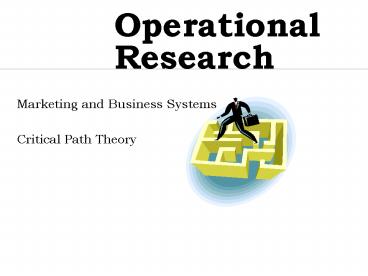Operational Research PowerPoint PPT Presentation
1 / 14
Title: Operational Research
1
Operational Research
- Marketing and Business Systems
- Critical Path Theory
2
Introduction
- Operational Research started in earnest during
the Second World War. It involved British
scientists from mathematics, psychology,
sociology and behavioural science which gives an
indication of some of the intangible factors
behind trying to find optimal solutions to
problems. - The Elevator problem illustrates this.
3
Critical Path Theory
- We are going to look at one part of OR, critical
path theory. - We need some definitions first.
- Project. This defines a combination of
interrelated activities. (e.g. Build a house,
Decorate a room, Put a woman on Venus, Graduate
in 2007) - Activity. Something that usually requires time
and resources. - Note from the above examples that some activities
need to be completed before others can start.
4
Example
- Suppose that to Build a House we require
- 15 days to lay the foundations
- 23 days to build walls
- 11 days to build the roof
- 6 days for plumbing
- 5 days for electricity
- 6 days for plaster
- 3 days for painting
- 2 days for garden
5
Example
- It is clear that by adding up all the days we
know how long this project is going to take.
However it may be that we can start some
activities before others are completed. This
would cut down on the total time. - We can represent our example by an arrow diagram.
But first we need some conventions.
6
Network (Arrow) Diagrams and Rules
- A typical arrow is represented as
- 7
- A
B - Where A must be completed before B and 7 is the
time allocation - Any activity is only represented by one arrow
- A completed network has only one start and one end
7
Back to our example
- Activity Description Immediate Predecessor
- A Foundations -
- B Walls A
- C Roof B
- D Plumbing A
- E Electricity B
- F Plaster D,E
- G Garden D,E
- H Paint F
8
Can You Construct The CP Diagram For our Example?
- Can you then determine the minimum project time?
- We know from before that the total time is 71
days. But we can shorten this by starting some
jobs before others have finished. For example the
plumbing and roof can start as soon as the walls
are done.
9
Example
5
Electric
11
Roof
Plaster
23
6
15
5
Walls
Paint
6
3
End
Start
Foundations
23
Garden
2
Plumbing
6
10
Example
- Can you see from the diagram that the shortest
time is - 152311563 63 Days
- As well as the shortest project schedule time we
have determined the critical path. It is - A, B, C, E, F, H.
11
Critical Paths
Of course the diagrams can become much more
complicated, which is the bad news. The good news
is that computers have arrived! To ensure that
data is input correctly and to make the process
more formal and efficient, some conventions have
been adopted. (The theory was developed in 1958
by the US Naval Special Projects Office).
12
New Rules
- A typical arrow is now represented as
- 7,12
- A
B - Where 7 in the example is the earliest start time
and 12 would be the earliest finish time. Note 12
is just 7 5 in our example, so 5 is the actual
activity time. - Look at our previous example.
13
Formal Arrows
49,54
Electric
38,49
Roof
Plaster
15,38
54,60
0,15
49,54
60,63
Walls
Paint
38,44
End
Start
Foundations
15,38
Garden
54,56
Plumbing
38,44
14
Further Reading
- Almost any book on OR will give much more detail
and highlight the additional features of Critical
Path Theory, such as slack time in projects and
the really critical activities. - More in depth analysis allows for projects to
make best use of resources (overtime and
equipment hire).

